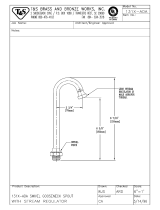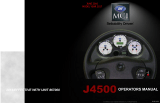Page is loading ...

PN 13259 04/2020
PART TITLE DATE CREATED CREATED BY REV.
13259 MANUAL OWNERS SERVICE WC 11/21/94 MS N
THIS DRAWING IS THE EXCLUSIVE AND CONFIDENTIAL PROPERTY OF AMEREX
CORPORATION. IT SHALL NOT BE DUPLICATED, USED OR DISCLOSED TO OTHERS
REV DRAWING CHANGE BY ECN# DATE
N PUBLISHER FILE CREATED; REFRESHED LAYOUT DESIGN CT B002026 4/29/20
COVER SHEET
DO NOT PRINT THIS PAGE FOR ACTUAL MANUAL. INTERNAL USE ONLY.
# NOTES
1 THIS COVERSHEET FOR INFORMATIONAL PURPOSES ONLY - DO NOT PRINT THIS PAGE IN MANUAL.
2 DESCRIPTION: MANUAL OWNER’S SERVICE FOR WET CHEMICAL PORTABLES
3 ACTUAL PRINTED MATERIAL TO CONSIST OF ATTACHED
4 OVERALL SIZE OF PRINTED DOCUMENT PAGES: 8-1/2” X 11” ON 20 LB PAPER
5 PRINTED MATERIAL TO MATCH ATTACHED IN SADDLE STITCHED BOOKLET FORM
6 PRINT MATERIAL IS TO BE HOLE PUNCHED 3 EACH 1/4” HOLES DOWN LEFT SIDE FOR STD 3-RING BINDER
7 CURENT REVISION DATE: 4/20

PN 13259 04/2020
All fire extinguishers shall be installed, inspected, and maintained in accordance with the National Fire Protec-
tion Association standard titled "Portable Fire Extinguishers", NFPA 10, or the National Fire Code of Canada
and the requirements of local authorities having jurisdiction.
When maintenance is indicated, it shall be performed by trained persons having proper equipment. Fire
extinguishers are pressure vessels and must be treated with respect and handled with care. They are mechan-
ical devices and require periodic maintenance to be sure that they are ready to operate properly and safely.
Amerex strongly recommends that the maintenance of portable fire extinguishers be done by a trained profes-
sional – your local authorized Amerex Distributor.
Amerex Corporation makes original factory parts available to insure proper maintenance – USE OF SUBSTI-
TUTE PARTS RELEASES AMEREX OF ITS WARRANTY OBLIGATIONS. Amerex parts have machined
surfaces and threads that are manufactured to exacting tolerances. O-rings, hoses, nozzles, horns, and all
metal parts meet precise specifications and are subjected to multiple in-house inspections and tests for
acceptability. There are substitute parts available that are incorrectly labeled as UL component parts, some are
advertised as Amerex type. None of these meet UL requirements, and all of them void the Amerex extinguisher
warranty and UL listing. DO NOT SUBSTITUTE.
RECHARGE FIRE EXTINGUISHERS IMMEDIATELY AFTER ANY USE
OWNER’S SERVICE MANUAL
INSTALLATION, OPERATING & SERVICING INSTRUCTIONS
MANUAL PN 13259
WET CHEMICAL PORTABLE EXTINGUISHERS
MODELS B260 & B262
AMEREX CORPORATION DOES NOT SERVICE, MAINTAIN, OR RECHARGE FIRE EXTINGUISHERS.
THIS MANUAL IS PUBLISHED AS A GUIDE TO ASSIST QUALIFIED SERVICE PERSONNEL IN THE
INSPECTION, MAINTENANCE, AND RECHARGE OF AMEREX FIRE EXTINGUISHERS ONLY. NO
INSTRUCTION MANUAL CAN ANTICIPATE ALL POSSIBLE MALFUNCTIONS THAT MAY BE
ENCOUNTERED IN THE SERVICE OF FIRE EXTINGUISHERS. DUE TO THE POSSIBILITY THAT PRIOR
SERVICE PERFORMED ON THIS EQUIPMENT MAY HAVE BEEN IMPROPERLY DONE, IT IS
EXTREMELY IMPORTANT THAT ALL WARNINGS, CAUTIONS, AND NOTES IN THIS MANUAL BE
CAREFULLY OBSERVED. FAILURE TO HEED THESE INSTRUCTIONS COULD RESULT IN SERIOUS
INJURY. AMEREX ASSUMES NO LIABILITY FOR SERVICE, MAINTENANCE, OR RECHARGE OF FIRE
EXTINGUISHERS BY PUBLISHING THIS MANUAL.
AMEREX CORPORATION – P.O. BOX 81 – TRUSSVILLE, ALABAMA 35173-0081
Phone: 205/655-3271 Fax: 800/654-5980
e-mail: sales@amerex-fire.com Web Page: http://www.amerex-fire.com
REFERENCES IN THIS MAUNUAL:
NFPA 10 Portable Fire Extinguishers
JJJJJJJJJJJJJJJJJJJJJJJJJJJJJJJJJJJJJJJJJJJJ
CGA C-1 Methods for Pressure Testing Compressed Gas
Cylinders
CGA C-6 Standard for Visual Inspection of Steel
Compressed Gas Cylinders.
National Fire Code of Canada
AVAILABLE FROM:
National Fire Protection Association, 1 Batterymarch Park,
Quincy, MA 02169-7471
Compressed Gas Association, 14501 George Carter Way,
Chantilly, VA 20151-2923
Compressed Gas Association, 14501 George Carter Way,
Chantilly, VA 20151-2923
National Research Council Canada, 1200 Montreal Road,
Ottawa, ON K1A 0R6 Canada

PN 13259 04/2020
INSPECTING THE EXTINGUISHER
This extinguisher shall be inspected at regular intervals (monthly or more often if circumstances require) to
insure that it is ready for use.
INSPECTION NFPA 10 A “quick check” shall be made of the extinguisher for the following:
1. Located in designated place.
2. No obstructions to access or visibility.
3. Operating instructions on nameplate (label) and facing outward.
4. Tamper seal not broken or missing.
5. Determine fullness by weighing or "hefting".
6. Examine for obvious physical damage, corrosion, leakage, or clogged nozzle.
7. Pressure gauge reading in the operable area.
MAINTENANCE – SERVICE PROCEDURE
At least once a year (or more frequently if indicated by an inspection), maintenance shall be performed.
Maintenance is a “thorough check” of the extinguisher. It is intended to give maximum assurance that an
extinguisher will operate effectively and safely. It includes a thorough examination and any necessary repair
or replacement. It will normally reveal the need for hydrostatic testing.
1. Clean extinguisher to remove dirt, grease, or foreign material. Check to make sure that the instruction
nameplate is securely fastened and legible. Inspect the cylinder for corrosion, abrasion, dents, or weld
damage. If any of these conditions are found and you doubt the integrity of the cylinder, hydrostatically
test, using the proof pressure method and a suitable cage, in accordance with CGA Pamphlet C-1 and
NFPA 10.
NOTE: When cleaning avoid use of solvents around the pressure gauge. They could seriously
damage the plastic gauge face.
2. Inspect the extinguisher for damaged, missing, or substitute parts. Only factory-replacement parts are
approved for use on Amerex fire extinguishers.
3. Weigh extinguisher, and compare with weight printed on the Maintenance section of the nameplate
(label). Recharge extinguisher if weight is not within the indicated allowable tolerances.
4. Check the date of manufacture on the extinguisher cylinder hanger loop or on the extinguisher nameplate.
Cylinder must be hydrostatically tested every 5 years to the test pressure indicated on the label.
REPLACE EXTINGUISHING AGENT WITH NEW AMEREX CHARGE AT TIME OF HYDROTEST.
5. Visually inspect the pressure gauge:
a. If bent, damaged, or improper gauge, depressurize and replace.
b. If pressure is low, check for leaks.
c. If over pressurized (overcharged), invert the extinguisher and reduce to 50 psi (345 kPa) by depressing
the valve lever. Repressurize to 100 psi (690 kPa). Check for leaks.
CAUTION: Be prepared for some discharge of liquid.
6. Inspect the footstand (base). If cracked or broken, replace with proper footstand.
7. Check pull pin for freedom of movement by breaking the tamper seal and removing the pull pin. Replace
the pull pin if bent or if removal is difficult.

PN 13259 04/2020
8. Inspect discharge lever for dirt or corrosion that might impair freedom of movement. Inspect carrying
handle for proper installation. If lever, handle, or rivets are damaged or distorted, replace with proper
Amerex part(s).
9. Remove hose assembly, inspect hose assembly for damage, replace as necessary. Blow air through hose
assembly to insure passage is clear of foreign material.
10. Inspect the valve assembly for corrosion or damage to hose thread connections. Replace valve assembly
or component parts as necessary following the proper depressurization and recharge procedures.
11. Install hose assembly into operating valve. Torque swivel nut lightly with 15/16” wrench. Install in hose
clip.
12. Install new tamper seal, and record service data on the extinguisher inspection tag.
13. Rehang the extinguisher on the wall hanger bracket making sure that it fits the hanger bracket properly –
replace the bracket if necessary.
RECHARGE
RECHARGING is the replacement of the extinguishing agent and includes the expellant for this type of
extinguisher.
WARNING: a. Before attempting to recharge be sure this extinguisher is completely depressurized.
b. Use a regulated nitrogen pressurizing source. Set the regulator no more than 25 psi
(172 kPa) higher than the gauge operating pressure.
c. Check and calibrate regulator gauge at frequent intervals. The regulator gauge shall be
used to determine when the intended charging pressure has been reached. Do not use the
extinguisher gauge for this purpose.
d. Never leave an extinguisher connected to a regulator of a high-pressure source for an
extended period of time. A defective regulator could cause the cylinder to rupture due to
excessive pressure.
RECHARGING PROCEDURE
1. Complete the “Maintenance-Service Procedure”, items 1 thru 10.
2. Discharge all remaining pressure and wet chemical solution, making sure that there is no remaining
pressure. Do not top off or reuse wet chemical.
3. Remove the valve assembly and disassemble by removing downtube assembly (use a wrench on the
brass retainer, not the plastic tube), spring, and valve stem from the valve assembly. Remove the collar
O-ring from the valve assembly. Install a new valve stem and O-ring after lightly lubricating with V-711 (do
not lubricate valve stem seal).
4. Thoroughly rinse all parts with clean water and wipe dry with a soft cloth. Blow the valve out with air or
nitrogen. Inspect the collar O-ring, valve stem and spring – replace parts if worn or damaged. Lubricate
the collar O-ring and small O-ring on the valve stem with V-711 (do not lubricate the valve stem seal).
Inspect the downtube. If it is cracked or deformed, replace with proper downtube (see Parts List). Inspect
downtube O-ring; replace if necessary.
5. Remove fill tube. Rinse the cylinder with clean water, and inspect the interior following CGA Visual
Inspection Standard, Pamphlet C-6. Replace fill tube.
6. Model B260 (6 liter) – Recharge using the Model 530-2 Liquid Charge following the instructions on the
package.
Model B262 (2½ Gallon) – Recharge using the Model 660 Liquid Charge following the instructions on the
package.
7. Install a “Verification of Service” collar around neck of cylinder. Install valve assembly to the cylinder and
properly align.

PN 13259 04/2020
CAUTION: TIGHTEN VALVE COLLAR NUT BY HAND ONLY. DO NOT USE WRENCH.
8. Install a PN 09492 Fill (Pressurizing) Adapter on the valve outlet (where the hose assembly attaches), and
pressurize with nitrogen to 100 psi (690 kPa). The pressure regulator shall be set to no more than 125 psi
(862 kPa). Remove Fill Adapter.
9. Check the collar, gauge, cylinder welds, and valve orifice for leaks using a leak detection fluid or a solution
of soapy water. Remove leak detection fluid from the valve assembly by blowing out with air, and wipe
exterior of the extinguisher dry.
10. Install hose assembly into the operating valve. Torque swivel nut lightly with a 15/16” wrench. Install in
hose clip.
11. Install pull pin with ring facing front of the extinguisher. Install new tamper seal. Record recharge date,
and attach new recharge tag.
12. Weigh assembled extinguisher, and confirm that the total weight is within the allowable tolerances
indicated in the Maintenance section on the extinguisher nameplate (label).
TROUBLESHOOTING GUIDE
WARNING: Determine the source of a leak before the extinguisher is depressurized. THE EXTINGUISHER
MUST BE COMPLETELY DEPRESSURIZED BEFORE ANY ATTEMPT IS MADE TO DEVALVE
IT AND CORRECT ANY LEAKAGE PROBLEM. To depressurize – hold the extinguisher in an
inverted position and slowly squeeze the discharge handle. Some liquid remaining in the
downtube will be discharged so care shall be taken in the area used for depressurization.
Thoroughly clean all valve parts after depressurization and valve removal.
PROBLEM CORRECTIVE ACTION
1.
Leak at collar O-ring
Remove valve assembly, clean collar (knurled) nut thor-
oughly, and install new O-ring. Lubricate the O-ring with
V-711 (PN 06247).
2.
Leak through valve
Install new valve stem assembly. Check valve seat for
scratches or foreign matter.
3.
Leak around gauge
threads
Remove gauge, and reinstall using Teflon tape on the
gauge threads.
4.
Defective gauge
Remove defective gauge, and install a new PN 17420
gauge using Teflon tape on the gauge threads.
5.
Restricted or inter-
mittent agent
discharge stream
Check downtube strainer, and discharge nozzle for dirt,
sediment, or impediments. Clean or replace parts as
necessary.
6.
Leak in the cylinder
Contact Amerex if under warranty, otherwise mark
"Rejected" and return to owner.
7.
Broken footstand Install new footstand (PN 03109).
FOR REPLACEMENT PARTS SEE THE AMEREX PORTABLE AND WHEELED
PARTS BOOK PN 27277 AVAILABLE AT http://www.amerex-fire.com UNDER
MANUALS OF THE RESOURCE SELECTION.
/





